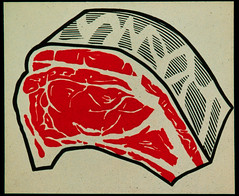I’ve been working with the White Labs Abbey IV yeast, which is reputed to be cultured from the Rochefort yeast strain, which I hadn’t used before. I normally repitch yeast from one bath to the next and generally build the strength of the beer up with each new batch since repitching also is the easiest way to build up a lot of healthy yeast. I started this run with Belgian Summer Ale and then a Dubbel and decided to finish it off with a Belgian Golden Ale. Luckily Belgian Golden isn’t as hard to brew as Dubbel. In fact it’s pretty easy. The grain bill was pretty straight forward: 80% pilsner malt and 20% sugar added to the kettle. This seems to be a good ratio because it allows you to make a fairly alcoholic beer (about 8-9%) that is also fairly dry, which makes it good with a variety of foods. The biggest problem with most homebrewed Belgian Goldens and Tripels is that they’re too sweet and don’t have the lightness on the palate that they should. Go try a bottle of Duvel or a bottle of Piraat and you’ll be amazed at the lightness of such a high alcohol beer. The key to beers like these is a low mash temperature (to make a highly fermentable wort that will have less residual sugar) and then to bump the wort up with a lot of sugar.
You also need a lot of healthy yeast to ferment this much sugar. If you don’t pitch enough yeast or if the yeast isn’t healthy enough, chances are that it will quit working before all of the sugar is gone and you’ll have a sweet beer which is nothing like the genuine article. I generally like to think that the best Belgian Goldens are made by producing a highly fermentable wort, pitching a lot of yeast, and then getting out of the way to let the yeast actually make the beer. It seems that the more neutral flavored the wort, the more the yeast can express itself. This isn’t a beer style where you want to use darker malts or crystal malts. I also think it’s best to use neutral sugars like corn sugar that ferment cleanly and don’t leave any residual flavors behind like dark sugars do (although dark sugars are wonderful in Dubbels and dark strong ales).
I tend to stick to pretty traditional hops for these beers and generally go with Saaz, Styrian Goldings, Goldings (or a derivative like Willamette), or Hallertauer (and it’s derivatives like Mt Hoods) and use a lighter hand. You want the bitterness in the 25-35IBU range, which is pretty mild by NW standards. I also don’t add a lot of hops to the finish because I don’t like too much hop aroma. F you put the later hops in about 15-20 minutes before the end you can get subtle floral and spice aromas without getting too much overt hop aromas.
These beers and their close relative, Abbey and Trappist Tripels, are great food beers because they have enough heft to stand up to a wide variety of food, but generally also have enough carbonation and dryness to cut through richer foods. The Tripels tend to be a little more elegant and refined, and the Goldens tend be drier and crisper. I normally try to keep one of them on tap all the time because they are so friendly. Unfortunately I did run out of my last one about 10 days ago and this one won’t be ready to be kegged for about 2 weeks (it will be drinkable at that point, but will mellow and round out after a few more weeks). They’re great with roasted chicken, pork, and shellfish, and could actually stand up fairly well to beef, particularly if it had a rich sauce (like steaks with béarnaise sauce). They’re also great aperitifs, but because of their alcohol content, you don’t want to have too many without some substantial food.
Saturday, July 21, 2007
Brewing Belgian Golden Ales and Tripels
Posted by
Bill
at
1:09 PM
![]()
![]()
Labels: Belgian Golden, Duvel, Piraat, Tripel
Subscribe to:
Post Comments (Atom)

1 comment:
Much fun to read your thoughts and facts. Keep it coming!
Post a Comment